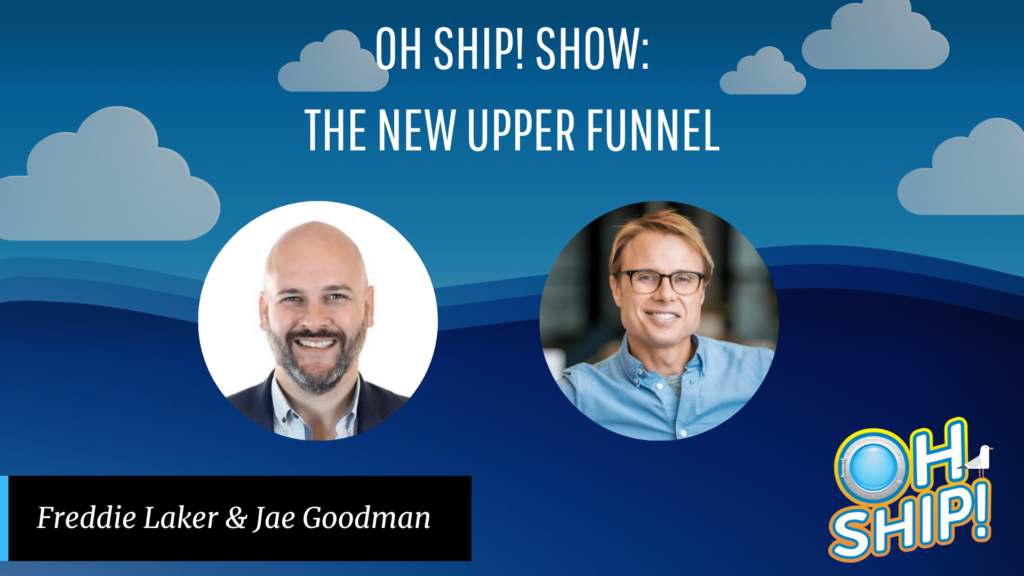Jae shares how the marketing funnel has completely changed—and how to adapt.
Jae Goodman is CEO of Observatory Agency, recognized by Fast Company in 2020 and 2021 as one of the world’s most innovative companies. He also teaches at UCLA and is a board member of the FEs. Today, Jae challenges us with innovative thinking about what he calls the new upper marketing funnel. In a nutshell, marketers need to start acting like producers and redefine the relationship between brands and entertainment.
Pioneering a New Kind of Advertising
How did this idea start to take shape? While watching TV, Jae caught himself fast-forwarding one of his own commercials. “I had a professional existential crisis,” he says. “The thing I was making appeared to be imminently going away.”
He approached the Creative Artists Agency (CAA) with a novel idea: creating a marketing services company focused on producing advertising experiences that engage and entertain rather than interrupt. They asked if he would build it inside CAA in collaboration with their existing marketing consultancy. Together, they could populate it with strategists, brand team members, and creative professionals who would be instantly connected to the global ecosystem of content creators and talent.
It was a hyper-collaborative environment, and they had a great run together. But as they approached their second decade with CAA, their approach shifted toward doing key brand product launches through fully integrated, year-long campaigns. “We became more of a core marketing asset, and we were being asked to pitch some of the biggest brands in the portfolios of our clients and potential clients,” Jae says. CAA’s core business was entertainment and sports, not marketing—it was time to strike out on their own. So, with backing from CAA, they found an incredible partner, Stagwell, and launched Observatory. And soon, their work with Chipotle, creating incredible stop-animation films as well as live events, would put them on the map.
The Emergence of the New Upper Funnel
The new upper funnel was born out of the modern marketer’s dilemma, explains Jae.
“The modern marketer’s dilemma is this: Content consumption on any device, any age, any human, content consumption is up, and way up. And pre-pandemic, way up,” Jae asserts. “However, something else is way up, which is ad avoidance.” Smaller devices have ad blockers; larger devices can fast-forward. Even while watching live sports, people look at their phones during a commercial break.
That means marketers have to actually create entertainment and experiences that attract and engage customers. That sits at the very top of the funnel—above awareness, consideration, trial, purchase, loyalty, and advocacy.
In the new upper funnel, things that used to be seen as complementary marketing assets are now becoming the crux of an advertising campaign. Brands must create entertaining media such as films, TV shows, games, and live experiences, telling a compelling story through content-centric, fully integrated campaigns. “What that means is the center of the campaign doesn’t have an interruptive ad,” says Jae. “It could be a mobile game; it could be a live experience, it could be a piece of music, it could be obviously a feature film, a documentary, a short film—anything that audiences, meaning humans, would choose to engage with as opposed to being interrupted with.”
For example, Nike partnered with Waffle Iron Entertainment to make The Day Sports Stood Still through a partnership set up by Observatory. Originally, they aimed to tell the story of how the COVID shutdown affected athletes, putting cameras on athletes around the world. But following the murder of George Floyd, the focus shifted. “Our COVID shutdown movie actually became a witnessed account of how the NBA, and more importantly its players, went through the process to decide that they were going to use the NBA as a platform for social justice,” Jae says. This resulted in an extremely compelling film that HBO purchased.
Pepsi was doing this extremely well a decade ago with its “Uncle Drew” film, says Jae. After the success of its film-like commercials featuring that character, it co-produced a movie about him. Both were huge hits.
To bring such projects to fruition, Observatory forges partnerships between brands and streaming platforms. “It’s very difficult for a brand to work with a content company who does not accept advertising,” Jae asserts. “We would work upstream of the distributors and create brand partnerships with the production companies.”
Integration of advertising in TV and film has become much more creative over time, he notes. In contrast to the clunky product placements of the past, characters use products in a more natural way. For instance, Reese Witherspoon’s character drove a Buick in Big Little Lies. They spent years laying the groundwork for this move, making sure Reese and the production company knew about Buick’s reinvention and great products. “By the time that went into production, she believed, and the production team believed, that that character would believably drive a Buick. That was done upstream of the eventual distributor of Big Little Lies,” Jae explains.
They did the same with Queer Eye and the D2C men’s apparel company Bonobos. “We worked upstream of Netflix with the production company Scout, and Bonobos became a segment there,” he says. “When that hit Netflix, we actually got a call from the head of brand partnerships there, who essentially said some nice version of, ‘How the heck did you get that brand into our show?’”
“That evolved into us becoming Netflix’s brand partnership agency,” he says.
A Shift in Mindset
Today, you can’t make choices based solely on efficiency, says Jae. “As a marketer, if you are comparing the process and the expense and very importantly the KPIs associated with this new upper funnel with all the efficiency metrics of yesteryear’s media, then you’re dead already,” says Jae.
In the new upper funnel, you can’t observe the marketing ROI, media spend, or return on advertising spend (ROAS) in real-time. A lot of short-term evidence is anecdotal, and hard evidence appears months later. When you report quarterly results, it’s hard to make the leap to investing in something that will show results in six months, like a music video. But pouring more money into interruptive advertising would be foolish, Jae says. “We have no choice but to make the confidence play in creating content experiences in the new upper funnel.”
Bonobos has made that investment. “We did a big new upper-funnel piece of marketing with them–a documentary short about the definition of the evolution of masculinity,” Jae says. “This is a hardcore D2C digital acquisition company who had to take money out of that very established model and make a bet on the upper funnel.”
“You’re not gonna see those results on your dashboard in real-time, and you’re not gonna see that in your weekly ROAS calculation, but with a six-month look back after making this big new upper-funnel commitment—highest ROAS in Bonobo’s ten-year company history,” he affirms.
Patience is a virtue, he reminds us—and it can lend space for truly innovative thinking.








